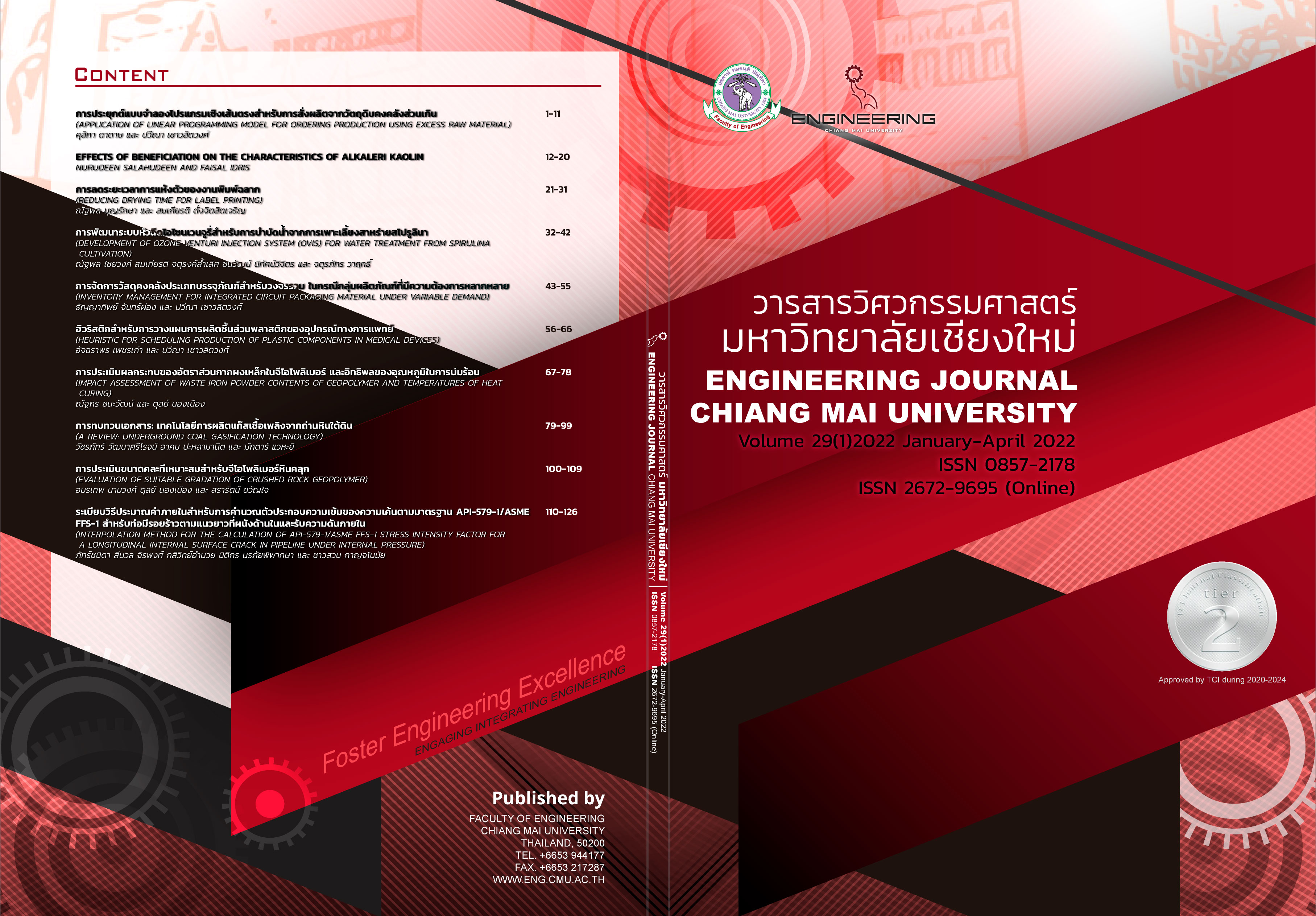Evaluation of Suitable Gradation of Crushed Rock Geopolymer
Keywords:
Ideal grading, Used Working Grading, Optimum Liquid Alkaline Activator Content, Unconfined Compression TestAbstract
A study of the compressive strength development in a geopolymer suitable for roadway applications. This study finds proper mixtures of crushed rock for geopolymer which use two mixed grading of crushed rocks sizes including: (1) use the ideal mixed size is called Ideal Grading for the road work with standard compressive strength was obtained by the most appropriate grading size, and (2) use mix of crushed rock is obtained from the stone mill, which is sorted by standard sieve sizes and mixed size that is close to the Ideal grading is called Used Working Grading. The two types of mixed sizes were used to activate with the alkaline solution, namely sodium hydroxide and sodium silicate. A sodium silicate to sodium hydroxide ratio of 0.67 and a sodium hydroxide concentration of 5 molar were used. To find a maximum dry density (MDD) and optimum liquid alkaline content (OLC), a standard compaction test and a modified compaction test were performed to obtain the compaction curve. Samples were prepared by mixing of crushed rock with alkaline liquid content in both dry and wet at 100%MDD and 95% MDD on compaction curve. The group of samples were stimulated by heat at 40ºC for 24 hours in oven in comparison with another group of samples that were cured at room temperature. After curing stage, both group of sample were left in ambient temperature to reach the curing time of 7 and 28 days before performing Unconfined Compression Test. The test results showed that compressive strengths of Used Working grading at 100%MOD for 28 days curing were higher than compressive strength of Ideal grading.
References
P. Jitsangiam, T. Suwan, S. Kwunjai, U. Rattanasak, and P. Chindaprasirt, “Development of alkali activated crushed rock for environmentally sustainable roadway rehabilitation,” International Journal of Pavement Engineering, 2021.
J. Davidovits, “Geopolymers: Inorganic Polymeric New Materials,” Journal of Thermal Analysis and Calorimetry, vol. 37, pp. 1633–1656, Aug. 1991.
D. Hardjito, S. E. Wallah, D. M. J. Sumajouw, and B. V. Rangan, “BRIEF REVIEW OF DEVELOPMENT OF GEOPOLYMER CONCRETE,” 2003.
P. Chindaprasirt, T. Chareerat, and V. Sirivivatnanon, "Workability and strength of coarse high calcium fly ash geopolymer," Cement and Concrete Composites, vol. 29, no. 3, pp. 224-229, 2007.
J. Davidovits, L. Buzzi, P. Rocher, D. Gimeno, C. Marini, and S. Tocco, "Geopolymeric cement based on low cost geologic materials. Results from the european research project geocistem," in Proceedings of the 2nd International Conference on Geopolymer, 1999, vol. 99, pp. 83-96.
อุบลลักษณ์ รัตนศักดิ์, “จีโอโพลิเมอร์ : วัสดุประสานสีเขียว,” วัสดุปูนซีเมนต์และจีโอโพลิเมอร์ผสม, หน้า 83–94, 2557.
อุบลลักษณ์ รัตนศักดิ์, วัสดุจีโอโพลิเมอร์. กรุงเทพฯ: สมาคมคอนกรีตแห่งประเทศไทย, 2560.
ปริญญา จินดาประเสริฐ, เถ้าลอยในงานคอนกรีต. กรุงเทพฯ: สมาคมคอนกรีตไทย, 2547.
สมิตร ส่งพิริยะกิจ, มาณัติ ภมะราภา, และ อุบลรักษณ์ รัตนศักดิ์, “วัสดุจีโอโพลิเมอร์,” พัฒนาเทคนิคศึกษา, ปีที่ 20, ฉบับที่ 65, หน้า 11–15, 2551.
วสันต์ ปั้นสงข์, บารเมศ วรรธนะภูติ, กฤฏณะ เพ็ญสมบูรณ์, และ จิรโรจน์ ศุกลรัตน์, “คุณสมบัติด้านความคงทนและความแข็งแรงของวัสดุชั้นพื้นทางที่ปรับปรุงด้วยซีเมนต์,” วิศวกรรมสาร มก., ปีที่ 23, ฉบับที่ 74, หน้า 75–86, 2553.
American Society for and Materials, Standard specification for coal fly ash and raw or calcined natural pozzolan for use as a mineral admixture in concrete (ASTM; C618-01),” ASTM International, 2015.
สำนักวิเคราะห์ วิจัยและพัฒนา, “วิธีการทดสอบความแน่นแบบมาตรฐาน (STANDARD COMPACTION TEST),”
กรมทางหลวงชนบท, มทช. (ท) 501.1-2545.
สำนักวิเคราะห์ วิจัยและพัฒนา, “วิธีการทดสอบความแน่นแบบสูงกว่ามาตรฐาน (MODIFIED COMPACTION TEST),” กรมทางหลวงชนบท, มทช.(ท) 501.2-2545.
สำนักวิเคราะห์ วิจัยและพัฒนา, “วิธีการทดสอบเพื่อหาค่าแรงอัดแกนเดียว (UNCONFINED COMPRESSION TEST),” กรมทางหลวงชนบท., มทช. (ท) 303-2545.
Downloads
Published
Issue
Section
License
ลิขสิทธิ์ของบทความที่ตีพิมพ์ในวารสารฉบับนี้จะยังเป็นของผู้แต่งและยินยอมให้สิทธิ์เผยแพร่กับทางวารสาร
การเผยแพร่ในระบบวารสารแบบเปิดนี้ บทความจะสามารถนำไปใช้ได้ฟรีในการศึกษา และในทางที่ไม่เกี่ยวกับการค้า




